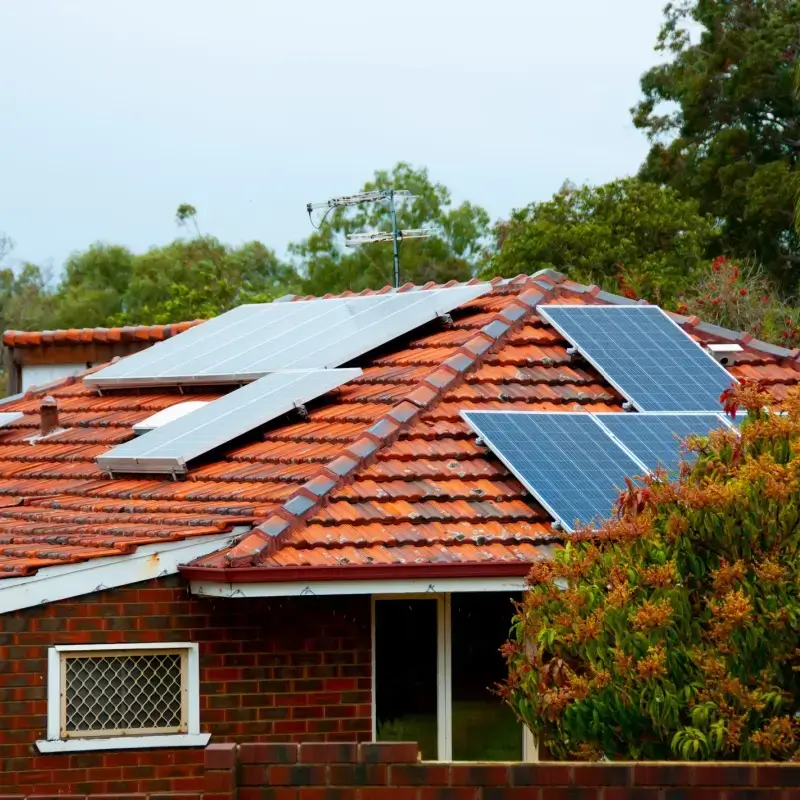Compare Electricity & Gas in Canberra and the ACT
Comparing energy in the ACT is Simples! Use your bill to get a quote in under 2 minutes











We don’t have access to all of the products available in your area: we do not compare all brands in the market, or all products offered by all brands. At times certain brands or products may not be available or offered to you. Learn more.
What’s the difference between types of ACT energy plans?
We’ve compiled this table on what our energy comparison service for the ACT can offer to customers and potential benefits you can receive by switching plans. This information should be used as a guide only, as it may vary depending on your address, whether natural gas is available at your property and the providers and plans we have available to compare.
Electricity only
Our service can detail options relevant to your property address, but not all plans or benefits may be available to you.
- Urgent same-day connections
- Solar feed-in tariffs
- GreenPower options
- Variable or fixed rates
- Standing offers
Gas only
If your home has natural gas, here’s how you can take control of your gas plan and save.
- Urgent three-business-day connections
- Tiered usage rates
- Standing Offers
- Same-day connections
- Renewable energy options
Electricity and gas
You can search and choose new electricity and gas plans at the same time – even if you’re choosing different providers.
- Urgent connections
- Mix and match your retailers
- Solar, electricity and gas rates
- Bill comparison
- Variable or fixed rates
Electricity only
Different plans will offer different deals. Compare now to see which benefits may be available to you.
- New customer sign-up-credit
- No exit fees
- Guaranteed discounts (e.g. 12-month benefit period)
- Conditional discount (e.g. pay-on-time)
- Perks (free subscription services, discounts on fuel, vouchers and more)
Gas only
Different plans will offer different deals. Compare now to see which benefits may be available to you.
- New customer sign-up-credit
- No exit fees
- Guaranteed discounts (e.g. 12-month benefit period)
- Conditional discount (e.g. direct debit)
- Perks
Electricity and gas
Different plans will offer different deals. Compare now to see which benefits may be available to you.
- New customer sign-up-credit
- No exit fees
- Guaranteed discounts (e.g. 12-month benefit period)
- Conditional discount (e.g. pay-on-time)
- Perks (free subscription services, discounts on fuel, vouchers and more)
Top 3 things to know about energy in the ACT
It pays to compare energy plans
Compare energy plans in minutes and start saving today.
Simple to use
Get started by answering a few quick questions to help us understand your needs.
Compare & save
Save time and money by easily comparing options from a range of providers side-by-side.
Switching is easy
Follow a few easy steps online to switch to a new deal that suits you and your budget.

Why compare with us?
Our smart comparison technology is trusted, free, safe and secure.

We believe the best decisions start with a comparison.
We’re proud to have helped millions of Aussies look for a better deal.


A guide to electricity and gas in the ACT and Canberra
Updated 26 June 2025David Koch has some tips for saving on your energy expenses
Find out how it’s possible avoid a bill that’s bigger than Capital Hill.


The ACT is Australia’s powerhouse. You’re the movers and shakers and policymakers. So why should you accept an energy bill that’s bigger than parliament hill? Compare the Market surveyed more than a thousand Aussies and found over half had been switching off to save when instead, they should be switching over.
Turning off lights or using the aircon less could save you a dollar or two. But by far, the best way to save is by comparing energy plans to make sure you’re on a competitive deal. Our experts at Compare the Market have these tips to help you navigate different rates, tariffs, and discounts. Number one, keep your energy bills on hand.
That way, you can compare plans based on your actual usage. You’ll get more accurate estimates to help you find good value. Two, compare your electricity and gas separately. If you have both, purchasing separate plans from different providers will often work out cheaper.
Number three, weigh up retail offers against the reference price so you can use it as a guide when searching for the best deal. The bigger the percentage, the better, but remember some retailers may have other deals and bill credit offers on top of the discount. And you don’t have to wait until your next bill’s due. Switching to a new electricity provider can take as little as two business days, which means you can potentially take advantage of your new rate sooner.
Meanwhile, gas suppliers will change over from your next billing date. It’s quick, it’s free, and Compare the Market makes it easier than you could imagine.
Avoid bill shock and get comparing today with Compare the Market.
Expert tips for reducing your energy bill
Get top tips on managing your electricity from our Head of Energy, Meredith O’Brien.

Switch energy plans with ease
If you find a new electricity plan you like, make the switch. These days you can switch in as little as two business days and start taking advantage of new rates quicker. In the past, a switch could take up to three months!
Compare separate electricity and gas quotes online
Always compare electricity and gas separately. Although energy retailers may offer bundled plans, if you’re looking for the cheapest energy providers in Canberra and the ACT, you’ll often find better deals by comparing them as stand-alone products.
Invest in energy efficient appliances
The ACT has cold winters and warm summers. Investing in energy-efficient appliances is one way to help keep electricity costs low (especially if you’re more reliant on your heater or air conditioner in extreme weather conditions).
Choosing the best ACT energy providers for you
How to compare electricity and gas in Canberra and the ACT

- Look for a cheaper plan. There’s a range of energy providers and plans available in Canberra and the greater ACT area. If you haven’t shopped around recently or if you’re on a standing offer, you may find a plan that better suits your usage needs and budget by comparing.
- Understand your property’s tariff. The tariff you’re on will impact how your provider charges you for electricity or gas. Some tariffs (such as time-of-use tariffs) can help you to look at ways to optimise energy consumption during times when energy rates are the cheapest.
- Take advantage of discounts and incentives. If you haven’t updated your energy plan in a while, you may find that your plan benefits or discounts have expired, or you’ve rolled on to a standing offer plan. Comparing energy plans can help you keep on top of offers with attractive discounts, potentially saving you money in the long run.
How the electricity market in the ACT works
In the ACT, the energy market is deregulated, meaning you can choose who you want as your energy provider. However, the ACT government provides a reference price each year that customers can use to compare retailers. Each electricity plan will have a percentage that shows how the plan relates to the reference price (e.g. 7% below the reference price).
Because customers in deregulated states and territories can choose their energy provider, these energy markets tend to see more competitive rates known as market offers. Market offers tend to be more affordable than standing offers for regulated zones as they sometimes include discounts and a fixed price or price guarantee period.
Simply put, this means that you have the freedom to compare energy providers in Canberra and the ACT and shop around for a plan that suits you on your terms.
The ACT reference price
Electricity providers in Canberra and the ACT can set their own usage and supply charges but must disclose the price difference between the electricity plans they offer and the reference price.
The reference price helps you identify potentially unfair energy costs by offering a benchmark price that’s based on your location’s average annual electricity usage.
The reference price applies to residential customers on flat or time-of-use tariffs regardless of whether there’s a controlled load tariff or not. For small business customers, it only applies to flat tariffs where prices for electricity supply don’t include controlled load tariffs.
Here are the 2024-2025 ACT reference prices:
| Customer type | Annual reference price |
|---|---|
| Residential customer (no controlled load) | $2,432 |
| Residential customer (with controlled load) | $3,018 |
| Small business customer | $4,711 |
| Source: ACT Government. Utilities (Reference Price) Determination 2024. Published June 2024. Accessed December 2024. | |
New South Wales (NSW), South East Queensland (QLD) and South Australia (SA) have the Default Market Offer (DMO) instead, which is used as a maximum price that retailers can charge electricity customers on a standing offer. In Victoria, they use the Victorian Default Offer (VDO).
Energy distributors and providers in Canberra and the ACT
Canberra and ACT electricity providers
Our energy comparison service can help you compare electricity and gas providers in Canberra, the ACT and beyond. Simply enter in a few details, like your energy usage and address, and within minutes you can compare electricity and gas plans in Canberra from a range of energy providers.
You can see which electricity suppliers in Canberra offer electricity by reviewing the list of electricity providers below.
- ActewAGL
- Amber Electric
- CovaU Energy
- Energy Locals
- EnergyAustralia
- Nectr
- Origin Energy
- Red Energy
The information provided above is based in the postcode of 2600 and is accurate as of 6 June 2025. Data sourced from the Australian Energy Regulator (AER).
We don’t compare products from all electricity providers on this list as we don’t compare all brands in the market, or all products offered by all brands.
ACT electricity and gas providers
The following energy providers in Canberra and the ACT are dual fuel providers that offer both electricity and gas:
- ActewAGL
- CovaU Energy
- EnergyAustralia
- Origin Energy
- Red Energy
The information provided above is accurate as of 6 June 2025. Data sourced from the Australian Energy Regulator (AER).
Cheapest electricity in Canberra and the ACT
When it comes to finding the cheapest electricity provider in Canberra and the ACT, it’s important to compare because the exact plans and providers available to you will depend on where you live, your meter type and more.
To help you get started, we’ve compiled a table of the cheapest electricity from each provider in the ACT.
| Provider/Retailer | Plan Name | Annual Cost (inc. discounts) | Annual Cost (excl. discounts) | Discount Benefit Period | Contract Term |
|---|---|---|---|---|---|
| Origin Energy | Origin Everyday Rewards Variable – Feel at Home Offer | $1,760.00 | $1,760.00 | 1 Year | 1 Year |
| ActewAGL | Simple Saver plan (iSelect) | $1,850.00 | $1,850.00 | 1 Year | 1 Year |
| Red Energy | Living Energy Saver (010) | $2,080.00 | $2,080.00 | None | None |
| Energy Locals | Local Rewards | $2,100.00 | $2,100.00 | None | None |
| EnergyAustralia | Flexi Plan | $2,120.00 | $2,250.00 | 1 Year | Ongoing |
| Nectr | Nectr Standing Offer Time of Use | $2,430.00 | $2,430.00 | None | None |
| CovaU Energy | CovaU Basics Residential TOU 7 Days | $2,460.00 | $2,460.00 | None | None |
| Amber Electric | Standing Offer: Fixed Rate | $2,530.00 | $2,530.00 | None | None |
The prices and information provided above are based on a house with two to three adults with no electric heating, hot water or underfloor heating and in the postcode of 2600 and are accurate as of 6 June 2025. Data sourced from the Australian Energy Regulator (AER). Plans and prices are subject to change.
Energy charges, tariffs and rebates
How is electricity and gas charged in the ACT
In Canberra and the greater ACT area, you’ll see two main charges on your electricity bill:
- A fixed daily supply charge for electricity to be distributed to your property.
- A usage charge for each kilowatt-hour (kWh) of the electricity you use, which is charged as cents per kWh (c/kWh). The more electricity you use, the higher your electricity bill will be.
For gas, you’ll also pay a fixed daily supply charge and a usage charge for each megajoule of gas used, charged as cents per megajoule (MJ; c/MJ).
Types of tariffs in the ACT
Tariffs are the pricing structures that influence the way providers charge you for your energy usage.
The following types of electricity tariffs may be applicable in the ACT:
- Single rate tariffs charge the same, flat rate for your energy usage no matter when or how you use electricity.
- Time-of-use tariffs charge different electricity rates for your energy use throughout the day or day of the week. These times are generally known as peak, off-peak and shoulder. You’ll need a smart meter to take advantage of a time of use tariff plan.
- Controlled load tariffs charge a lower, off-peak rate for large household appliances (like underfloor heating or electric hot water systems) that usually run during the night or in off-peak periods, but your appliances will need to be wired into a separate meter.
- Demand tariffs are a separate charge on your bill that vary depending on the intensity you use electricity during certain demand periods. This charge is in addition to the daily supply and usage charges.
What is a solar feed-in tariff?
 If you have a solar power system for your house or business, you may end up generating more solar energy than you use. With a solar feed-in tariff in the ACT, your solar system can feed extra and unused energy back into the electricity grid. You may get paid for it as a credit on your electricity bill.
If you have a solar power system for your house or business, you may end up generating more solar energy than you use. With a solar feed-in tariff in the ACT, your solar system can feed extra and unused energy back into the electricity grid. You may get paid for it as a credit on your electricity bill.
Solar feed-in tariffs can vary between energy providers in Canberra, so always consider this when comparing ACT energy plans.
What is the average residential electricity bill in the ACT?
The exact price of your electricity bill will vary depending on factors such as your household size, energy plan, electricity usage and more. However, for ACT residents with an annual consumption of 6,500 kWh, the yearly cost based on the ACT reference price is $2,267.1
However, you could stand to save on your bills if you switched to a market offer; the average market offer price is $1,967 on a single rate tariff and $1,960 on a time of use tariff. Just by switching to a cheaper market offer, you could potentially save hundreds of dollars on your electricity bills. However, it’s important to remember that the above is an average only – the offers available to you may differ in price and your household’s annual consumption will vary.
What energy concessions are available in the ACT?
The ACT offers a Utilities Concession for eligible residents, which can help you save money and minimise your overall cost of living.2
You may be eligible for the Utilities Concession if you’re the primary holder of one of the following cards:
- Veteran’s Affairs Pensioner Concession Card or Gold Card
- Pensioner Concession Card
- Low Income Health Care Card
- Health Care Card.
- ACT Services Access Card.
The concession covers electricity, gas, water and sewage, and you can apply for it by simply contacting your energy provider.
Find out more about seniors energy rebates and concessions and other state-based rebates you may be eligible for.
Where can I find the best energy deal in the ACT?
The best energy deal for you will depend on your financial circumstances, energy consumption habits and household. Every gas and electricity retailer offers varying rates, discounts, payment methods (including direct debit), exit fees (if any) and more. So, while the best deal for one person may be the cheapest plan, the best deal for someone else may be the most flexible.
Consider your personal circumstances while comparing energy plans. Our energy comparison service makes it easy to compare energy suppliers and plans in the ACT. You can compare the estimated total costs, usage costs, daily supply charges and other fees.
Meet our Head of Energy, Meredith O’Brien
As the Head of Energy at Compare the Market, Meredith O’Brien believes in educating Australian customers about the everchanging gas and electricity market so they can adjust their energy usage habits and get the most out of their energy plans.
Meredith has six years within the energy industry, following 15 years of experience in financial services and is currently studying a Master of Business Administration. Meredith is a dedicated customer advocate who is passionate about empowering Australians to find the right products to suit their needs by removing the confusion from comparing.
Want to know more about energy?
1 Independent Competition and Regulatory Commission (ICRC). Electricity price investigation 2024-27. Published May 2024. Accessed December 2024.
2 ACT Government – ACT Revenue Office. Electricity, Gas and Water Rebate. Accessed December 2024.

